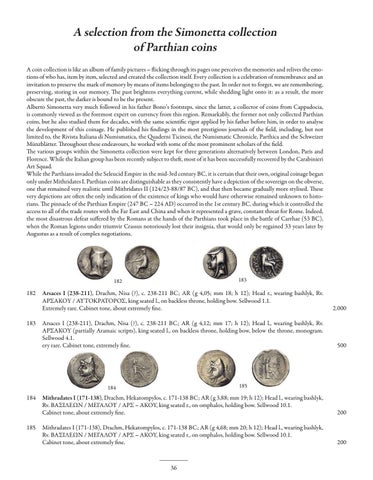A selection from the Simonetta collection of Parthian coins A coin collection is like an album of family pictures – flicking through its pages one perceives the memories and relives the emotions of who has, item by item, selected and created the collection itself. Every collection is a celebration of remembrance and an invitation to preserve the mark of memory by means of items belonging to the past. In order not to forget, we are remembering, preserving, storing in our memory. The past brightens everything current, while shedding light onto it: as a result, the more obscure the past, the darker is bound to be the present. Alberto Simonetta very much followed in his father Bono’s footsteps, since the latter, a collector of coins from Cappadocia, is commonly viewed as the foremost expert on currency from this region. Remarkably, the former not only collected Parthian coins, but he also studied them for decades, with the same scientific rigor applied by his father before him, in order to analyse the development of this coinage. He published his findings in the most prestigious journals of the field, including, but not limited to, the Rivista Italiana di Numismatica, the Quaderni Ticinesi, the Numismatic Chronicle, Parthica and the Schweizer Münzblätter. Throughout these endeavours, he worked with some of the most prominent scholars of the field. The various groups within the Simonetta collection were kept for three generations alternatively between London, Paris and Florence. While the Italian group has been recently subject to theft, most of it has been successfully recovered by the Carabinieri Art Squad. While the Parthians invaded the Seleucid Empire in the mid-3rd century BC, it is certain that their own, original coinage began only under Mithridates I. Parthian coins are distinguishable as they consistently have a depiction of the sovereign on the obverse, one that remained very realistic until Mithridates II (124/23-88/87 BC), and that then became gradually more stylised. These very depictions are often the only indication of the existence of kings who would have otherwise remained unknown to historians. The pinnacle of the Parthian Empire (247 BC – 224 AD) occurred in the 1st century BC, during which it controlled the access to all of the trade routes with the Far East and China and when it represented a grave, constant threat for Rome. Indeed, the most disastrous defeat suffered by the Romans at the hands of the Parthians took place in the battle of Carrhae (53 BC), when the Roman legions under triumvir Crassus notoriously lost their insignia, that would only be regained 33 years later by Augustus as a result of complex negotiations.
183
182
182 Arsaces I (238-211), Drachm, Nisa (?), c. 238-211 BC; AR (g 4,05; mm 18; h 12); Head r., wearing bashlyk, Rv. ΑΡΣΑΚΟY / ΑΥΤΟΚΡΑΤΟΡΟΣ, king seated l., on backless throne, holding bow. Sellwood 1.1. Extremely rare. Cabinet tone, about extremely fine.
2.000
183 Arsaces I (238-211), Drachm, Nisa (?), c. 238-211 BC; AR (g 4,12; mm 17; h 12); Head l., wearing bashlyk, Rv. ΑΡΣΑΚΟY (partially Aramaic scripts), king seated l., on backless throne, holding bow, below the throne, monogram. Sellwood 4.1. ery rare. Cabinet tone, extremely fine.
500
185
184
184 Mithradates I (171-138), Drachm, Hekatompylos, c. 171-138 BC; AR (g 3,88; mm 19; h 12); Head l., wearing bashlyk, Rv. ΒΑΣΙΛΕΩN / ΜΕΓΑΛΟΥ / ΑΡΣ – ΑΚΟY, king seated r., on omphalos, holding bow. Sellwood 10.1. Cabinet tone, about extremely fine.
200
185 Mithradates I (171-138), Drachm, Hekatompylos, c. 171-138 BC; AR (g 4,68; mm 20; h 12); Head l., wearing bashlyk, Rv. ΒΑΣΙΛΕΩN / ΜΕΓΑΛΟΥ / ΑΡΣ – ΑΚΟY, king seated r., on omphalos, holding bow. Sellwood 10.1. Cabinet tone, about extremely fine.
200
36
